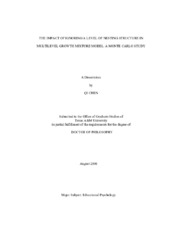| dc.description.abstract | The number of longitudinal studies has increased steadily in various social science
disciplines over the last decade. Growth Mixture Modeling (GMM) has emerged among
the new approaches for analyzing longitudinal data. It can be viewed as a combination of
Hierarchical Linear Modeling, Latent Growth Curve Modeling and Finite Mixture
Modeling. The combination of both continuous and categorical latent variables makes
GMM a flexible analysis procedure. However, when researchers analyze their data using
GMM, some may assume that the units are independent of each other even though it may
not always be the case. The purpose of this dissertation was to examine the impact of
ignoring a higher nesting structure in Multilevel Growth Mixture Modeling on the
accuracy of classification of individuals and the accuracy on tests of significance (i.e.,
Type I error rate and statistical power) of the parameter estimates for the model in each
subpopulation. Two simulation studies were conducted. In the first study, the impact of
misspecifying the multilevel mixture model is investigated by ignoring a level of nesting
structure in cross-sectional data. In the second study, longitudinal clustered data (e.g.,
repeated measures nested within units and units nested within clusters) are analyzed
correctly and with a misspecification ignoring the highest level of the nesting structure. Results indicate that ignoring a higher level nesting structure results in lower classification
accuracy, less accurate fixed effect estimates, inflation of lower-level variance estimates,
and less accurate standard error estimates, the latter result which in turn affects the
accuracy of tests of significance for the fixed effects. The magnitude of the intra-class
correlation (ICC) coefficient has a substantial impact when a higher level nesting structure
is ignored; the higher the ICC, the more variance at the highest level is ignored, and the
worse the performance of the model. The implication for applied researchers is that it is
important to model the multilevel data structure in (growth) mixture modeling. In addition,
researchers should be cautious in interpreting their results if ignoring a higher level nesting
structure is inevitable. Limitations concerning appropriate use of latent class analysis in
growth modeling include unknown effects of incorrect estimation of the number of latent
classes, non-normal distribution effects, and different growth patterns within-group and
between-group. | en |


